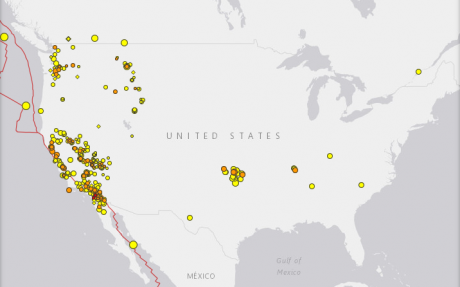Steve Bull's Blog, page 1244
November 29, 2017
Monetary Imperialism

Photo by Nathaniel St. Clair
In theory, the global financial system is supposed to help every country gain. Mainstream teaching of international finance, trade and “foreign aid” (defined simply as any government credit) depicts an almost utopian system uplifting all countries, not stripping their assets and imposing austerity. The reality since World War I is that the United States has taken the lead in shaping the international financial system to promote gains for its own bankers, farm exporters, its oil and gas sector, and buyers of foreign resources – and most of all, to collect on debts owed to it.
Each time this global system has broken down over the past century, the major destabilizing force has been American over-reach and the drive by its bankers and bondholders for short-term gains. The dollar-centered financial system is leaving more industrial as well as Third World countries debt-strapped. Its three institutional pillars – the International Monetary Fund (IMF), World Bank and World Trade Organization – have imposed monetary, fiscal and financial dependency, most recently by the post-Soviet Baltics, Greece and the rest of southern Europe. The resulting strains are now reaching the point where they are breaking apart the arrangements put in place after World War II.
The most destructive fiction of international finance is that all debts can be paid, and indeed should be paid, even when this tears economies apart by forcing them into austerity – to save bondholders, not labor and industry. Yet European countries, and especially Germany, have shied from pressing for a more balanced global economy that would foster growth for all countries and avoid the current economic slowdown and debt deflation.
…click on the above link to read the rest of the article…
Supreme Court to Debate Warrantless Collection Of Cellphone Records in Huge Fourth Amendment Battle
In one of the most important Fourth Amendment battles of the digital age, the Supreme Court is preparing to tackle a case involving law enforcement accessing cellphone records without a warrant.
On Wednesday the US Supreme Court is scheduled to address the case of Carpenter v. United States to determine whether or not law enforcement should be required to obtain a warrant before accessing the cellphone records of an individual. The case deals with a set of armed robberies that took place between December 2010 and March 2011. Several men worked together to rob RadioShack and T-Mobile stores in the Michigan and Ohio areas, stealing cell phones and holding store employees and customers hostage in the process.
A couple of the men were arrested and quickly confessed afterwards. However, one man remained at large. With one of the suspect’s phones in their possession, the FBI gained access to”transactional records” from various wireless carriers for 16 different phone numbers contained within the phone. These records contained all the location info and call records made to and from the phone. Using the “cell-site records” pulled off the phone, the FBI was able to locate and arrest the final suspect, Timothy Carpenter. He was charged and convicted by a jury of aiding and abetting robbery that affected interstate commerce, and aiding and abetting the use or carriage of a firearm during a federal crime of violence. Carpenter now faces life in prison for his crimes.
The FBI gained access to the cell-site records using provision set forth by the Stored Communications Act, which was passed in 1986 to deal with the protection of information stored digitally.
…click on the above link to read the rest of the article…
North Korea Says “Completed State Nuclear Program”; Warns “The Whole US Is In Range”
North Korea claims its “new ICBM can put whole U.S. mainland within range,” says it has “realized great historic cause of completing state nuclear force”
* * *
Following the successful test-firing of its longest range ICBM yet today, Yonhap News reports, citing North Korean media, that North Korea will make an important announcement at noon Seoul time (10:30pm ET).
Presumably, Kim’s comments will be a braggadocio reaction to President Trump and General Mattis’ comments (begins around 6:30):
Mattis warned “[North Korea] R&D is accelerating and they now appear to have the capability to launch an ICBM attack on anywhere in the world” to which Trump replied “we will take care of it… it is a situation we will handle.”
Trump then tweeted later this evening: “After North Korea missile launch, it’s more important than ever to fund our gov’t & military! ”
North Korea announces that it “successfully” fired a new Hwasong-15 missile with improved technology, according to an announcement read on state-run television on Wednesday.
Kim gave the order to test fire the missile, state-run Korean Central News Agency said.
“After watching the successful launch of the new type ICBM Hwasong-15, Kim Jong Un declared with pride that now we have finally realized the great historic cause of completing the state nuclear force, the cause of building a rocket power,” KCNA said.
The new missile “brings the whole US mainland within North Korea’s range.”
None of which is news as we already reported these details.
But perhaps the most notable claims is that North Korea says it has “realized great historic cause of completing state nuclear force”
November 28, 2017
54 Things You Didn’t Know About Natural Gas

Every once in a while, I will realize that I have spent way too much time talking about oil, complaining about pipelines, Permania, free money and the impending “End of Big Oil because of Electric Vehicles”. And it’s on those days that my attention turns to oil and coal’s neglected stepsister who we know as natural gas. And in the spirit of American Thanksgiving, I would like to say that I, for one, am thankful for natural gas, the current turkey of the energy sector.
Like oil, natural gas is a prolific fossil fuel with many uses, however I feel that it floats unnoticed under the radar, particularly because it is so much easier to carpet bomb oil and coal into submission (as opposed to cute and cuddly natural gas) in the great anti-fossil fuel war of attrition.
So herewith – 50 (or is it 54?) things to know, love, think and be thankful for about natural gas, in no particular order of importance and apologies if I miss really obvious ones.
1. Natural gas is used to provide heat, hot water and cooktop fuel to almost 80 million homes in North America
2. Natural gas represents almost 25 percent of all primary energy use in North America and globally, rapidly closing the gap on coal
3. It is cleaner burning than all the other combustible fuel alternatives such as whale blubber, wood, peat, coal, rolled-up newspapers and oil.
4. It is so plentiful in North America that supplies are estimated at anywhere from 50 to 100 years at current consumption levels, although this might involve fracking under Philadelphia, so maybe not. Canadian supplies are somewhere in the 300-year range. Because the supplies are so prolific in North America, the prices are quite disconnected from oil and on a heat content basis, significantly undervalued
…click on the above link to read the rest of the article…
US Neocon Wars Open Pandora’s Box in Europe

Photo by DAVID HOLT | CC BY 2.0
To some on the geopolitical stage, “stability” is something like a sacred word.
Of course, the devil is in the details. For decades, the word was used by successive US governments in a sense which did not preclude a certain number of wars – as long as those wars, whether officially declared or merely approved by an American President under the terms of some special Congressional authorization such as the one which is behind most current US military activity, were begun and carried out on American terms.
“Stability” was and remains the justification employed in defending United States support for some truly nasty governments, kings and dictators. Their professed opposition to communism or terrorism – as defined by the US government, of course – has been the primary qualification for that support. Although there was often talk of democracy, cosmetic moves purported to lead in that direction would usually suffice to sell the relationship to Congress, and in more than a few cases even the cosmetic mask is absent: it is simply asserted that the nation in question is a crucial strategic domino, the fall of which would put the entire world in jeopardy, and our noble principles must needs be temporarily suspended. Some of these temporary suspensions have lasted for decades now.
The dreaded scourge of instability, however, has now reached the heart of the empire.
In Germany (Western Europe’s biggest economy, as a result of massive American efforts to rebuild it as a protegee bulwark against the Soviet Union after World War II), preliminary negotiations designed to enable the formation of a new governing coalition broke down this week.
…click on the above link to read the rest of the article…
Are markets Really as Calm as They Seem?
Indicators for financial market “stress” have reached their lowest levels in decades. For instance, stock market volatility has never been this low since the early 1990s. Credit spreads have been shrinking, and prices for credit default swaps have fallen to pre-crisis levels. In fact, investors are no longer haunted by concerns about the stability of the financial system, potential credit defaults, and unfavourable surprises in the economy or financial assets markets. How come?

Monetary policy plays the significant role. By slashing interest rates and ramping up the quantity of money in the banking system, central banks around the world have kick-started the economies following the 2008/2009 crash. But this is not the full story. The fact that investors expect central banks to stand at the ready to fend off a slowdown of the economy and price declines in stock and housing markets is by no means less important.
The truth is that investors expect central banks to provide a “safety net.” This expectation encourages them to make risky investments again (which they would otherwise have declined). That said, central banks have caused a colossal ‘moral hazard’: Investors feel pretty much assured that the risk-reward profile of their investments has become more favorable — that they can enjoy a considerable upside, while the downside is limited.
As a result, investors drive asset prices upwards. As stock prices rise, firms’ cost of capital falls, encouraging risky investments. Consumers, with their real estate assets appreciating, go into even more debt. Maturing debt is rolled over at low interest rates, and borrowers’ spending capacity increases. In other words: The downward manipulation of interest rates and the decline in risk aversion translates into a cyclical strengthening of the economy.
…click on the above link to read the rest of the article…
November 27, 2017
Why do we need jobs if we can have slaves working for us?
We normally assume that anything that creates jobs is a good thing, but is it, really? Is our current prosperity related to having “jobs”? Isn’t it, rather, the result of the large number of “energy slaves” working for us in the form of fossil fuels? Today, everyone of us has probably more slaves in terms of available energy output than even the richest in the ancient world could have. But, in the ancient world, the rich Roman patricians knew the source of their wealth and practiced “otium” (a term untranslatable in English) intended as the search of pleasure and knowledge free from the needs of everyday survival – with their human slaves taking care of that. In our times, instead, we tend to neglect, or even actively deny, the role of our fossil slaves. We state, and maybe even believe, that our antics (“jobs”) are what makes us live and we engage with gusto in the equivalent of digging holes in the ground and filling them up again as a good way to make us rich by increasing the numerical value of that curious deity we call “dʒiːdiːˈpiː” (or “GDP”). Maybe it is because, deep down, we know that, sooner or later, our fossil slaves are going to evaporate into thin air and leave us.
This is a post by Nate Hagens and DJ White. Rich in ideas and concepts, it is longer than the average post on Cassandra’s Legacy but well worth the effort of reading, savoring each sentence in it. Working drafts copyright ©2010-2017 – Not to be reproduced in any form without the explicit permission of the authors

by NJ Hagens & DJ White, EarthTrust
First, some review of relevant points:
…click on the above link to read the rest of the article…
The Importance of Tree Crops in Sustainable Agriculture

THE IMPORTANCE OF TREE CROPS IN SUSTAINABLE AGRICULTURE
Tree Crops are the most common perennial agricultural method. More specifically, orchards are one of the most common and successful forms of perennial agriculture. A well-maintained peach orchard will give you a steady crop for up to 20 years. An apple orchard can last up to 50 years and well-maintained pecan tree may very well continue to produce for up to 150 years. Our agricultural systems have been designed almost exclusively for staple annual crops. However, transitioning into perennial agricultural systems that can produce food staples is one of the challenges we´ll face in the coming years in order to create a sustainable form of agriculture.
THE FUNCTIONS OF A TREE
A perennial agriculture system based on the cultivation of tree crops offers a number of advantages over the traditional annual agriculture methods of staple carbohydrates such as corn and wheat. While these systems to take several years to get established, once production has begun the main body of work is maintenance and harvest. Tree crops such as fruit and nuts, then, can become a staple of our diet without having to till the soil year after year.
Permaculture asks us to find several functions for every element. Trees are perhaps one of the most useful elements in any permaculture design. Some of the functions of a tree agriculture system include:
Harvest: From fruits to nuts to edible leaves and shoots to mushrooms, there are a number of food products that trees can provide.
Mulch: The leaf fall from deciduous trees provides some of the best mulch material for your farm and is fundamental in building overall soil health.
…click on the above link to read the rest of the article…
There Have Been 698 Earthquakes In California Within The Past 30 Days
 Why is the west coast shaking so violently? According to the latest data from Earthquake Track, there have been 698 earthquakes in California within the past 30 days. By the time that you read this article, that number will undoubtedly have changed. In recent days I have felt such an urgency to write about the seismic activity on the west coast, and I am quite concerned that so few people seem to be paying attention to what is happening.
Why is the west coast shaking so violently? According to the latest data from Earthquake Track, there have been 698 earthquakes in California within the past 30 days. By the time that you read this article, that number will undoubtedly have changed. In recent days I have felt such an urgency to write about the seismic activity on the west coast, and I am quite concerned that so few people seem to be paying attention to what is happening.
As I have covered previously, scientists tell us that when seismic activity begins to escalate the probability of having a major earthquake jumps significantly. Over the past month there have been more mainstream news articles about earthquake swarms in California than I have seen in years, and the magnitude 4.6 earthquake that rattled Monterey County earlier this month made headlines all over the world.
And it isn’t just the U.S. section of the “Ring of Fire” that seems to be awakening. I have written about Mt. Popocatepetl down in Mexico several times recently, and on Friday it erupted three more times…
Spectacular eruptions have been seen Southeast of Mexico City as Mexico’s Popocatepetl volcano spewed smoke and ash high into the air.
The volcano had three eruptions Friday, one of which reached two and a half miles into the sky.
The first explosion occurred at about 5:00 p.m. local time.
Two more explosions overnight spread ash over the villages and fields south of the volcano.
I cannot stress enough how potentially dangerous this situation could become. In ancient times, Mt. Popocatepetl completely covered entire Aztec cities with massive amounts of super-heated mud. Scientists assure us that someday Mt. Popocatepetl will once again erupt in a similar fashion, and the devastation that this will cause will be off the charts.
…click on the above link to read the rest of the article…
Forget About Catalonia And Brexit, The Next European Black Swan Could Be Transylvania
Over the past 100 years, the borders in Central and Eastern Europe have been redrawn time and time again, often leaving groups of people separated from their home country by new borders. Although land often changed hands relatively peacefully, suddenly finding one-selves as an ethnic minority in a new country was bound to lead to tension and resentment.
 Walle1886 / Pixabay
Walle1886 / PixabayWhile these resentments may reveal real disenfranchisement of ethnic minorities in Central Europe, politicians, especially populist figures, have seized on the outsider narratives inherent in the diaspora experience.
As the April 2018 election approaches in Hungary, Prime Minister Viktor Orban has been reaching out to the Hungarian minority in Romania, drawing criticism from Romanian leaders, while his supporters insist he is trying to lend his support Hungarians everywhere.
Rooted in History
Tensions between Romania and Hungary can be traced back to World War I and the Treaty of Trianon.
Although the Treaty of Trianon ended hostilities between the Allied Powers and the Kingdom of Hungary, the peace came at a great price to the Austro-Hungarian successor state. Hungary lost 2/3rd of its population and territory, leaving the former imperial hub landlocked in the heart of Central Europe. Most of its territory was ceded to Yugoslavia, Czechoslovakia, and Romania, as well as Austria, Italy, and Poland. Romania was granted the entire region of Transylvania, where an estimated 1.3 million ethnic Hungarians reside, making Hungarians Romania’s largest minority.
The loss of such a large chunk of territory and population would certainly leave its mark on national memory. Recently in Hungary, politicians have been revitalizing this narrative.

By derivative work: CoolKoon (talk)
Hungary1910-1920.png: The original uploader was Fz22 at English Wikipedia
(Original text: fz22 (talk)) – Hungary1910-1920.png, CC BY-SA 3.0, Link
…click on the above link to read the rest of the article…








